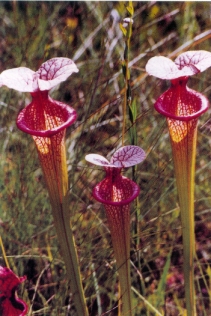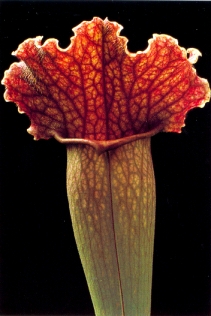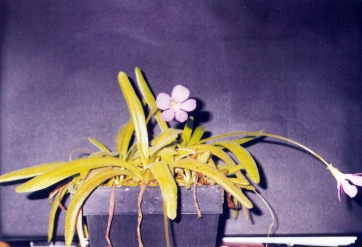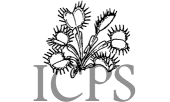|
Carnivorous Plant Newsletter
Volume 29, Number 4, December 2000, pages 116 - 122
NEW CULTIVARS
Sarracenia 'Adrian Slack'
Sarracenia 'Vintage Slack'
Pinguicula 'Aphrodite'
Cephalotus 'Hummer's Giant'.
Sarracenia 'Adrian Slack'
Received: 10 May 2000
When the idea for an issue of Carnivorous Plant Newsletter commemorating Adrian Slack was developed, it was obvious that it would be an ideal time to christen a cultivar Sarracenia 'Adrian Slack'. To live up to its namesake this cultivar would have to be something special, so I (BMR) looked for candidates. During my search, I contacted Peter D'Amato (California Carnivores). Peter said that while he had some lovely plants worth cultivar status (see Sarracenia 'Vintage Slack', below), he had another idea. Long ago, Peter had visited Bob Hanrahan's property in Alabama and saw a hybrid so beautiful that it brought him to his knees in rapture. This sounded good! I called Bob, and even though Bob has grown a vast number of Sarracenia over the years on his property and in his greenhouses, he knew exactly which clone I was inquiring about. He said that the plant was still alive, and that he would send a photograph.
I have seen many Sarracenia plants, but when the photo from Bob arrived, my jaw dropped. Clearly, this extraordinarily colorful and well-shaped clone was the long sought candidate for Sarracenia 'Adrian Slack . We nominated and submitted this cultivar name for registration on 28 March 2000.
While the exact parentage of Sarracenia 'Adrian Slack' is unknown, it is almost certainly a mix of S. flava and S. leucophylla. It is unclear if back-crossing is involved. In general form, the plant produces large pitchers much like those of S. flava. The influence of S. leucophylla is expressed, at most, as a slight undulation in the pitcher lid. While S. flava controls the pitcher form, S. leucophylla influences much of the pitcher coloration. The pitcher lid is arrestingly white, shot through with deep red veins (from S. flava). The upper pitcher tube is also heavily veined and lightly fenestrated. These pitcher characters define this exquisite cultivar. The flowers are not as spectacular as the pitchers, but are still intriguing. The petals are light pink, almost white, but may show occasional yellow highlights.
Bob found this plant in the 1980s, growing in the Milton area of western Florida. It has grown well since then, and when left undisturbed produces the astonishing coloration documented in the photograph. This is a superior plant, and honors a superior man.
Sarracenia 'Adrian Slack' is very rare in cultivation, but is being propagated under guard for future distribution. Specimens are not yet available, but news on how to obtain it will be made public when the plants are ready.
BOB HANRAHAN, BARRY MEYERS-RICE • Powder Springs, GA • USA

Sarracenia 'Vintage Slack'
Received: 10 May 2000
This plant is a S. x mitchelliana cross. This cultivar is similar to typical S. x mitchelliana crosses, but has a particularly noteworthy feature: the collar and lid has a distinguishing white- rarely seen in similar hybrids. The pitcher tube is primarily green with whitish-pink fenestrations in the front upper part. The reduced ala is edged in red. The collar and lid are held upright, extremely frilly and bear abundant bristly hairs on the lower inner surface. The collar's yellow-green background is overwhelmed by burgundy veins and carmine-pink blotches that extend to the upper back of the pitcher tube. The pitchers are never more than 30 cm (12 inches) tall. The flower petals are red.
This plant was sent to me long ago from Bob Hanrahan. I recognized the quality of the plant shortly after it reached maturity I coined the name 'Vintage Slack' on 31 January 2000, and submitted it for registration on the same day. The name, of course, honors Adrian Slack, who among other things is a noted wine-enthusiast. It is appropriate that this multicolored plant, which appears stained by many different wines, was selected for cultivar status on our property, as we are located at a winery. This cultivar should only be reproduced by vegetative means.
PETER D'AMATO • Forestville, CA • USA

Pinguicula 'Aphrodite'
Submitted for registration on 23 February 2000
In July 1998 Mr. Jan Flisek made a bilateral cross-pollination of the Mexican plants Pinguicula agnata and P. moctezumae. Four weeks later, ripe seeds were harvested from P. agnata, whereas the pollinated P. moctezumae did not produce seed. Mr. Kamil Pasek sowed most of the seeds (from two developed capsules) under sterile conditions in vitro at the end of August 1998. The rest of the seed was sown conventionally. Germination of the seeds was in both cases almost 100% within 3-4 weeks.
Owing to rapid in vitro growth over a period of 18 months, we were able to observe the nature of a large number of individual plants. We did not find any significant variability among the individual germinated plants; hence we regard all the individuals resulting from this crossbreeding as identical. The plants are eminently interesting, unique and deserve a special epithet. We have sufficient information to describe the new cultivar we name Pinguicula 'Aphrodite' (see Figure 3).
The cultivar Pinguicula 'Aphrodite' is characterized by its very long, narrow leaves with rounded tips which terminate in a point. The summer rosette consists of up to 15 leaves which are up to 12 cm long and 2 cm wide; the leaf-edges roll downwards. The erect leaves display a characteristic, descending-arch along their lengths. Under intense summer sunlight, the leaf-edges of leaves can be reddish, whereas the leaf midribs remain green along their entire length. During the winter, the rosette size decreases, whilst the number of leaves increases to as many as 25. The leaves of the winter rosette are up to 5-6 cm long and 1.3 cm broad; mostly they are flat and light green.
The plants bloom all year round, indeed during winter the plants can have the most flowers open at the same time. The color and size of the flowers changes as the flowers age. Freshly open flowers are relatively small and are generally dark-violet. As the flowers age they enlarge and fade to pink. When viewed from the proper angle the petals reflect light to give a shiny appearance. The posterior side of the flower is significantly lighter in color. Gentle, faint veining is apparent over the entire surface of the five (very exceptionally six) petals; this venation is more distinct towards the flower center. The entrance to the corolla tube and the tube itself is bright yellow, and minutely hairy. Mature flowers can reach 4 cm in a diameter and this fact ranks them among the true giants of the Pinguicula! The spur of the flower is narrow, slightly bowed and may be up to 1.5 cm long. Flowering time is about four weeks depending on the growing condition. Flower stalks can reach 15 cm in length (exceptionally 22 cm), the upper part of the stalk (about 1-2 cm) can be brownish-red, and the lower part is green and covered with tentacles. The sepals are a rich green color. We have tried to crossbreed different individuals of Pinguicula 'Aphrodite', or Pinguicula 'Aphrodite' plants using other species and hybrids as pollen donors (namely, P. agnata, P. emarginata, P. esseriana, P. 'Gina', P. gracilis, P. 'Sethos', P. moctezumae, P. rotundiflora, or P. sharpii). However the plants have never produced any seeds so it seems Pinguicula 'Aphrodite' is sterile. We have used Pinguicula 'Aphrodite' as a pollen donor in hybrid crosses, and have produced seed several times. At present we are unsure about the quality of these seeds.
This cultivar is very vigorous and easy to grow using the standard methods for cultivating Mexican Pinguicula. Moist planting medium (but not waterlogged), even during the winter season, leads to better growth of the plant. We can recommend only one successful method to propagate this cultivar without any problems--using leaf cuttings.
This cultivar is named after Aphrodite, the Greek goddess of love and beauty. Beautiful Aphrodite was much in demand and liked by many of the gods. We hope that Pinguicula 'Aphrodite' will find a place in many collections of carnivorous plants as an adornment at least, just as Aphrodite was the gem of the Greek goddesses on Mount Olympus.
In addition to the above data we include a short description of the parental plants used in making Pinguicula 'Aphrodite'.
P. agnata (section Agnata; maternal plant): the diameter of the rosette is 25 cm, leaf 45 cm wide, the edge of the leaf is reddish in summer. The flower is white, 2.5 cm in diameter, with blue edges and a minute yellow central spot, fragrant. Origin unknown (plant was obtained at the floristic exposition, 1990).
P. moctezumae (section Orcheosanthus, paternal plant), the diameter of the rosette 20 cm, leaves green and narrow (7 mm). The flower is pink, 3 cm in diameter, with a wellmarked white central spot. Origin Oliver Gluch, Germany (1998).
We wish to extend great thanks, especially to Mr. Loyd Wix-England (loyd.wix@talk2l.com), Oliver Gluch-Germany (oliver.gluch@t-online.de), Barry Rice (barry@carnivorousplants.org), Jan Schlauer-Germany and Michiaki Mabuchi-Japan (mabuchi@vbl.kyoto-u.acjp) for their critical comments, and also we thank Mr. Marek Svitek for his help in making the English translation of this text. The plants Pinguicula 'Aphrodite' have been sent as a present to the above-mentioned friends and other ones some time ago. The plants can be obtained also from the addresses of both authors without any problems.
JAN FLÍSEK • Roznovská • Czech Republic;
KAMIL PÁSEK • Na Svobode • Czech Republic

Cephalotus 'Hummer's Giant'
Submitted for registration on 10 May 2000
In September of 1986 I received from Steve Beckwith (a pen pal in Adelaide Australia) about half a dozen good-sized plants of Cephalotus follicularis. All had deep maroon colored pitchers at least 5 cm (2 inches) in length that had over-wintered from the previous year's growing season. It was obvious that the plants had been dormant for some months and were just beginning to start their growing cycle again, It was the first evidence I had that the plants were perennials that required a dormant cycle.
I distributed a number of the plants to close associates and started growing the rest inside a terrarium where I have maintained them ever since. This was the beginning of what was to be a very successful venture into growing a particularly large and vigorous form of Cephalotus. Vegetatively propagated stock of it has thrived and multiplied through the years so much that I have been able to establish this particular clone into many private and commercial collections around the globe!
This particular clone produces pitcher leaves up to 6 cm (2.5 inches) in length and about 2.5 cm (1 inch) in width. It usually takes about three years for plantlets grown from leaf cuttings to reach maturity and full size. To my knowledge, only one other person growing this clone has obtained pitcher leaves larger than mine- Bill Mclaughlin of the US Botanical Gardens grew them to about 8 cm (3 inches) in length. (I never actually measured the pitcher leaves, but knew they were larger than mine.) His plant was grown under controlled conditions in a large conservatory, and may represent the maximum pitcher leaf size attainable with this clone. Since at maturity this clone reaches much larger sizes than normal Cephalotus plants in cultivation, I am establishing it as a cultivar, and am naming it Cephalotus 'Hummer's Giant' (see Figure 4). I coined this name April 3, 2000, although this cultivar name has been commonly used for the plant for years before that.
My growing experience has been with indoor terrarium type set-ups using a mixture of peat and white sand. Sphagnum on the surface is not recommended since it can often outgrow the plants and can require removal. The substrate should always be damp to the touch but well drained. This is very important. Rainwater is best, but distilled water is fine too. If the plants are to be grown using indoor terraria, the best lit location is in a large south-facing window (north-facing, for growers in the southern hemisphere) where the sun's rays will be the most prevalent. Your tank will get sufficient lighting from the sun without artificial lighting! The plants will receive optimal amounts (4-6 hours) of sunlight each day from late August to late March and early April. During the summer, when the path of the sun in the sky is very high, direct sunlight will not be able to enter the window and illuminate the terrarium. As such, direct light will cease from April until late August, but the plants will continue to receive high levels of indirect light. It is during this period of lower light that the plants produce their noncarnivorous leaves. If little or no sunlight is available fluorescent lights can be used. Place them no further than 15 cm (6 inches) above the plants, 14-16 hours a day.
Propagation can be done using almost any part of the plant, including the roots, but I use the noncarnivorous, flat leaves. It is easy and efficient. For a propagation chamber I use plastic tubs with scalable clear plastic lids, such as those available at salad bars. I fill the bottom half with live green Sphagnum (damp, not wet). After carefully pulling each leaf away from the parent plant so as to get the entire leaf stem, I slide the lower end at a 45' angle into the moss, laying the flat leaf blade on the surface. The container is then closed and put in high indirect (not direct!) sunlight, with temperatures at about 16-27C (60-80'F). After about a month or so the bottom end of the leaf stem will root, callous, or both. Soon after, one to several growth shoot will develop. Carefully separate the moss from around the leaf and pull up the leaf with the shoots and roots. This can be transferred into a permanent substrate. If further propagation is desired, use a small knife or pair of tweezers to carefully separate the shoot and root from the base of the leaf stem. The shoot can be planted, and the leaf can be reinserted back into the moss! I have used some leaves three times using this method, although usually after two times the leaf yellows and dies.
Root-rot is perhaps the biggest problem with Cephalotus, especially when a plant is moved or a tank is set up for the first time. Using a fungicide is of little help. Why it happens is probably a combination of factors which may include poor health and the presence of fungi and bacteria. Once a tank has a good number of established plants, additional plants seem to take well to their new environment. When setting up a tank with fresh peat and sand, it can take a while before it becomes "friendly" to newly plants, but once it does a stable micro-ecosystem is created.
It is important to remember that once Cephalotus plants are established, undisturbed for a long time, and have grown to a large size, they do not like being uprooted and disturbed! If you ever decide to move a large plant, take a good measure of the soil surrounding the plant too. This way you will not disturb the rhizome and root system too much. Use a knife! If you do not move your plants carefully like this, they will probably die. Young or small plants separated from larger ones usually do not seem to have this sensitivity to being moved. Usually supplying Cephalotus with a dormant period is something I have never attempted to do, since I have always grown the plants indoors. Ignoring the issue of dormancy has always caused me some concern. However, despite nearly fifteen years of experience with specimens of Cephalotus 'Hummer's Giant', I have yet to observe any problem that seems to be associated with the lack of giving them a cool dormancy period. During the spring and summer seasons, growth slows or may even stop. While I consider this a resting period, I certainly cannot classify it a true dormancy. Even so, it may give the plants enough of a rest to carry on their growing cycle. Clearly, the plants have continued to flourish and multiply for years. This is a surprising adaptation for a seasonal plant.
Editor's note: As John mentioned in his article, he has been distributing this cultivar for many years. Growers with gigantic Cephalotus specimens can be quite confident it is the same clone that John described in his article. John is busy with his fieldwork and collection, so is unable to send people specimens of this cultivar, but if you want it-look around. It is increasingly common in collections. (BAMR)
JOHN HUMMER • Arlington, VA • USA

|

